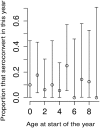Incidence of Dengue Virus Infection in Adults and Children in a Prospective Longitudinal Cohort in the Philippines
- PMID: 26845762
- PMCID: PMC4742283
- DOI: 10.1371/journal.pntd.0004337
Incidence of Dengue Virus Infection in Adults and Children in a Prospective Longitudinal Cohort in the Philippines
Abstract
Background: The mean age of dengue has been increasing in some but not all countries. We sought to determine the incidence of dengue virus (DENV) infection in adults and children in a prospective cohort study in the Philippines where dengue is hyperendemic.
Methodology/principal findings: A prospective cohort of subjects ≥6 months old in Cebu City, Philippines, underwent active community-based surveillance for acute febrile illnesses by weekly contact. Fever history within the prior seven days was evaluated with an acute illness visit followed by 2, 5, and 8-day, and 3-week convalescent visits. Blood was collected at the acute and 3-week visits. Scheduled visits took place at enrolment and 12 months that included blood collections. Acute samples were tested by DENV PCR and acute/convalescent samples by DENV IgM/IgG ELISA to identify symptomatic infections. Enrolment and 12-month samples were tested by DENV hemagglutination inhibition (HAI) assay to identify subclinical infections. Of 1,008 enrolled subjects, 854 completed all study activities at 12 months per-protocol undergoing 868 person-years of surveillance. The incidence of symptomatic and subclinical infections was 1.62 and 7.03 per 100 person-years, respectively. However, in subjects >15 years old, only one symptomatic infection occurred whereas 27 subclinical infections were identified. DENV HAI seroprevalence increased sharply with age with baseline multitypic HAIs associated with fewer symptomatic infections. Using a catalytic model, the historical infection rate among dengue naïve individuals was estimated to be high at 11-22%/year.
Conclusions/significance: In this hyperendemic area with high seroprevalence of multitypic DENV HAIs in adults, symptomatic dengue rarely occurred in individuals older than 15 years. Our findings demonstrate that dengue is primarily a pediatric disease in areas with high force of infection. However, the average age of dengue could increase if force of infection decreases over time, as is occurring in some hyperendemic countries such as Thailand.
Conflict of interest statement
The authors have declared that no competing interests exist.
Figures






References
-
- Gubler DJ (1997) Dengue and dengue hemorrhagic fever: Its history and resurgence as a global public health problem In: Gubler DJ, Kuno G, editors. Dengue and dengue hemorrhagic fever. New York: CAB International; pp. 1–22.
-
- Special Programme for Research and Training in Tropical Diseases., World Health Organization. (2009) Dengue: guidelines for diagnosis, treatment, prevention, and control. Geneva: TDR: World Health Organization; 147 p. p.
Publication types
MeSH terms
Substances
Grants and funding
LinkOut - more resources
Full Text Sources
Other Literature Sources
Medical

